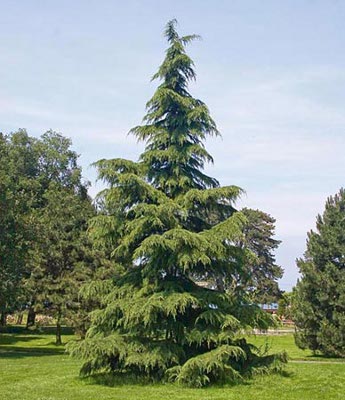Deodar Cedar Tree (Cedrus deodara)
Category: Evergreen Trees

The Deodar Cedar is a monoecious species from Himalayas which grows to an elevation of about 3500 to 12000 feet above the sea level. It has both its male and female cones on the same tree. It is a large stately conical shaped conifer which has horizontally spreading branches.
This tree, once established, grows very fast for the first or two decades. It usually grows to a height of about one fifty feet with a forty feet spread at the ground levels. However, in home gardens, the tree can grow to a height of approximately forty to seventy feet with a spread of twenty to forty feet. It usually forms a pyramidal shape. The tree has densely pubescent branchlets with downward droops at their tips. The lower branches are bent gracefully downwards then upwards again.
The Deodar Cedar tree has huge foliages which contains several needle shaped leaves that are arranged in whorls or which appear individually on long shoots. These whorls can be about twenty to thirty for each cluster. The needle shaped leaves can grow to about one to two inches long. They are usually grayish- green or bluish- green in color which always depends on the cultivator and the location.
The male cones are usually in the shape of a banana. In early spring, the cones produce clouds of wind blown pollen which are yellow in color. The female cones are egged shape, bluish- green in color and grow three to five inches long. After a period of two years, these cones, after maturity, becomes reddish-brown and shatter to produce little seeds which have papery wings.
The Deodar Cedar tree can do well in USDA zones of seven to nine. However, the 'Shalimar', 'Kashmir' and the polar can do well in USDA zones of six as they are able to withstand the cold conditions. The tree is drought tolerant which can establish well in neutral to alkaline soil and in full sun. This tree is favored for its weeping habit and is usually used to line streets, a specimen tree in parks and also as a Christmas tree.

 Back To Category Evergreen Trees
Back To Category Evergreen Trees